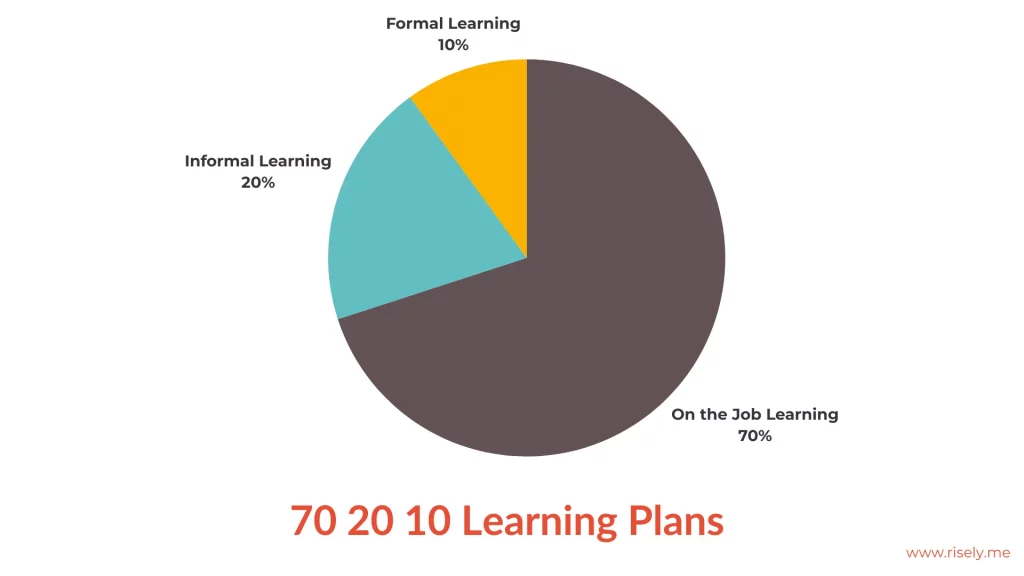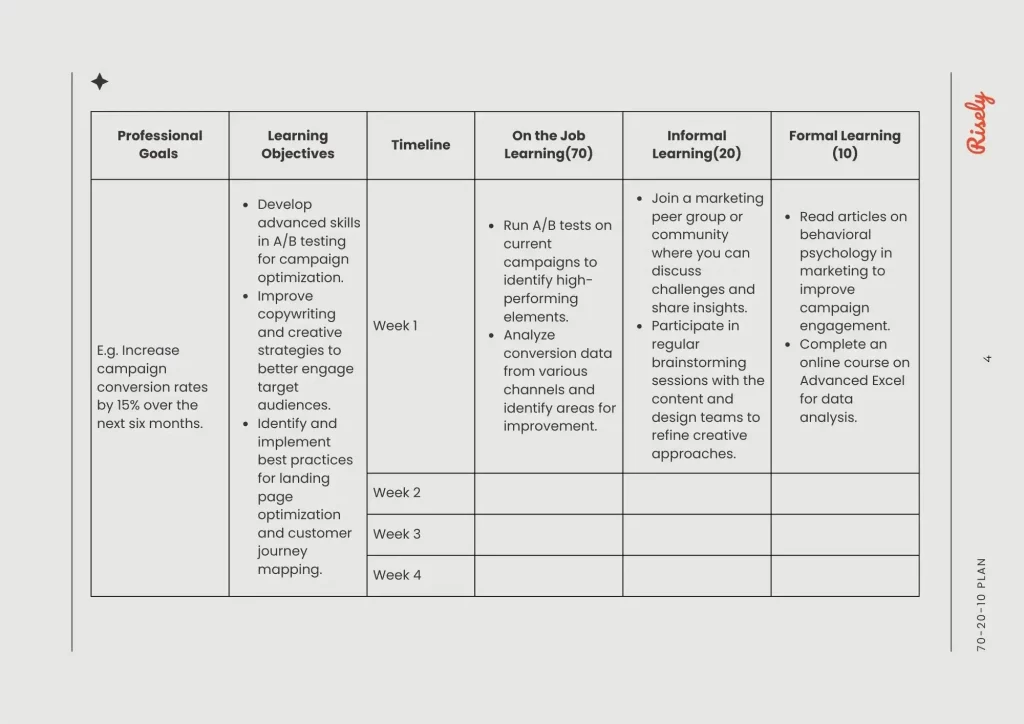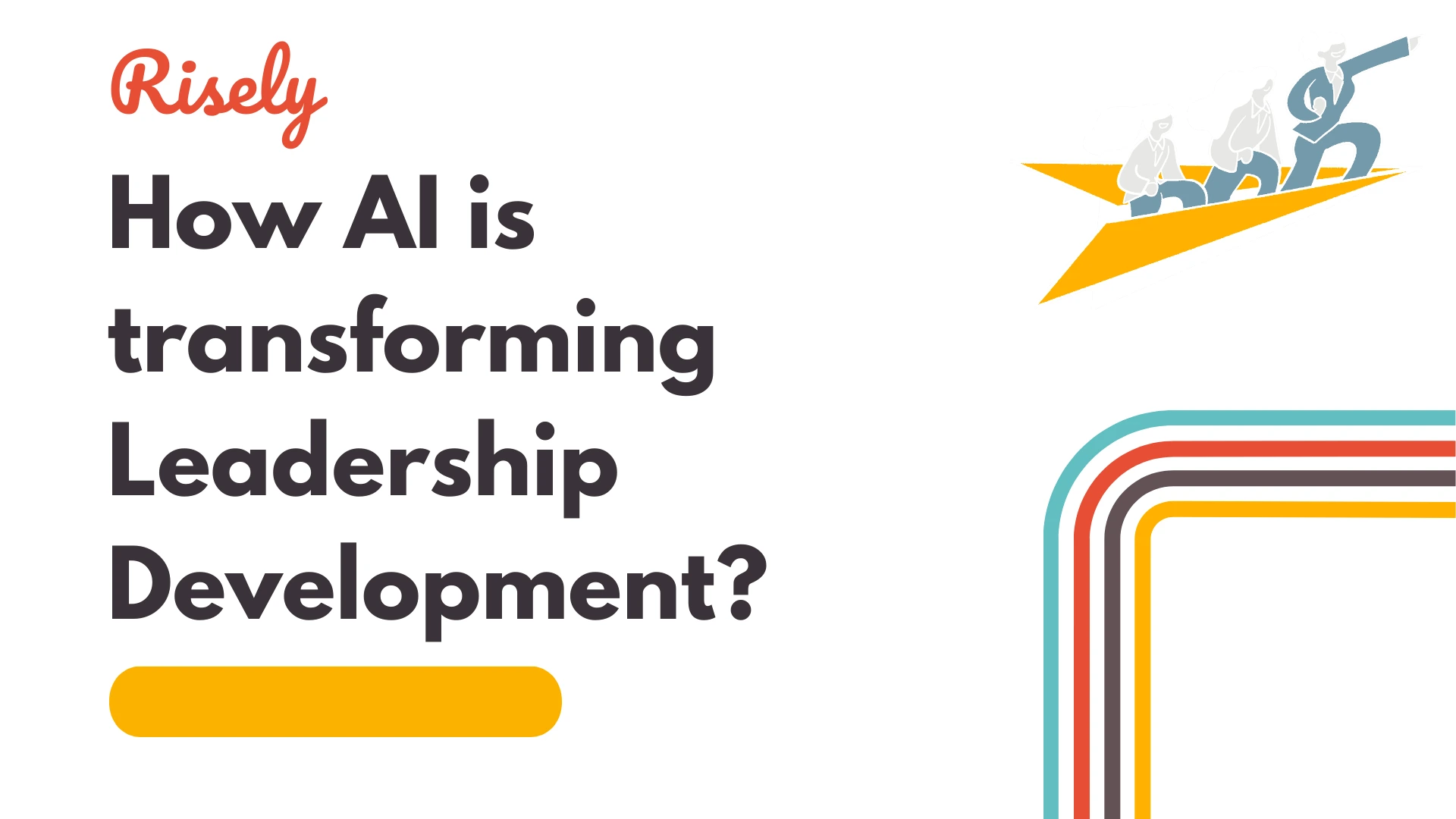Learning And Development 70 20 10 Plans (Free Template)
Is classroom training enough? Or can on-the-job training do the job? Neither can do justice to an organization’s learning and development needs. What you need to create an impactful L&D strategy is a balance between all these learning and development methods for teams. The learning and development 70 20 10 plan helps you visualize this mix accurately to meet your team’s needs. In this blog, we will further understand how learning and development 70 20 10 plans work, along with finding ways to effectively develop it for your team with Risely’s free template.What is the learning and development 70 20 10 plan?
The 70-20-10 Model for learning and development became popular in the 1980s for the development of managers. This model helps us understand how people learn new knowledge and skills. It moves away from focusing only on formal training. Instead, it shows that most learning happens through different experiences. According to this model, 70% of learning comes from job experiences, 20% from talking and working with others, and 10% from formal training programs. This way of learning reminds us that we should create an environment for learning. This environment should include real-world activities and sharing knowledge with others, not just classes and workshops.
How to set up the 70 20 10 plan for your organization?
Designing a strong 70 20 10 plan needs a clear strategy. It should match learning activities with the goals of the organization and the growth needs of individuals in your team. First, find out the skills and knowledge gaps in your organization. These gaps must be filled to reach your goals. After identifying these gaps, the next step is to build a plan. This plan will show how the 70 20 10 approach will be used. It should clearly explain the roles of everyone involved, like employees, managers, and learning professionals.Before you get started: Setting up the 70 20 10 framework
A clear 70 20 10 framework helps create a strong way to learn and grow. Here are some steps to set up your plan:- Start with a Needs Analysis: First, check the current skill levels in your organization. Look at the skills you will need in the future and identify any gaps. This analysis will help you focus on what skills to develop.
- Define Learning Objectives: Write down the specific knowledge, skills, and abilities that people should gain from the 70 20 10 plan. These objectives will help you measure how well your learning and development efforts are working.
- Establish a Supportive Environment: Create a culture that appreciates continuous learning. Give chances for growth and support employees in taking on challenging assignments. Encourage them to step out of their comfort zones and see challenges as helpful job experiences. Because a 70 20 10 plan steps away from conventional methods, this is very critical for success.
Incorporating Experiential Learning: The 70% Component
Experiential learning is key to the 70 20 10 model. People learn and remember better when they can apply what they know in real-life situations. This approach is not just about traditional classroom lessons. It focuses on practical, hands-on activities. To use experiential learning in workplaces well, provide chances for on-the-job learning. This allows people to try new things, solve problems, and gain real experience. Job rotations, new tasks, and shadowing others can help develop skills and allow team members to see different parts of the business. Also, encourage a friendly space for informal learning. Make sure team members feel safe to ask questions, share their knowledge, and learn from their mistakes. Let’s run an example of the learning and development 70 20 10 plans alongside to understand this matter. We have a manager; let’s call them Alex; your skills gap analysis shows they need to work on their people management skills to succeed in their first managerial role.Experiential learning for a manager: In the first step, i.e., experiential learning, they can practice delegation by assigning a real project or task to one of their team members. It will include ensuring the person has the resources needed and setting regular check-ins to monitor progress. After completing the task, Alex can reflect on what worked and what could be improved in their approach.
Leveraging Social Learning: The 20% Component
Humans are naturally social. The 70-20-10 model shows that social activities are key for learning. To promote knowledge sharing and teamwork, we should start mentoring programs, coaching between peers, and groups to share experiences. We can use technology to help social learning. You can do this by creating online spaces, discussion boards, and tools that let employees connect. It allows employees to share ideas and learn from each other no matter where they are. Creative leadership is very important for a great social learning space. Leaders should be the change agents and start to share their stories, be mentors, and create chances for their teams to work together and learn.Social learning for a manager: You set up peer groups of people managers in your company for discussions or join a manager network where they can exchange experiences and tips on leadership. Alex can also take mentoring sessions or small group discussions with experienced managers, which offer insights into successful delegation practices.
Implementing Formal Learning: The 10% Element
The 70 20 10 model is based on experiential and social learning, but formal learning is also very important. It gives structured knowledge and basic skills. Make sure that formal learning matches the skills found in your needs analysis. Formal training programs should add to and support what you learn from experiential and social learning. These programs can be in different forms, like workshops, online courses, industry certifications, and conferences. Think about mixed learning approaches. These can combine online lessons, interactive workshops, and hands-on tasks. Doing so can make learning more engaging and help people remember better. Focus on programs that get everyone involved, use real-life examples, and provide chances for feedback and reflection.Formal learning for a manager: Alex takes up the manager effectiveness masterclass on Risely, which offers in-depth ideas and insights on what it takes to succeed as a manager and gives real-life scenarios to practice on. The formal learning component in a 70 20 10 plan gives the theoretical framework for the learner to practice independently.
Using a 70 20 10 plan is just the start. You need to keep checking how well it works and change things if needed. Set clear ways to see how your learning and development (L&D) efforts affect both individual and team performance. Look at things like how engaged employees are, how well they keep what they learn, how they use their skills, and how these tie back to your plan’s goals. Continue reading: Comparing Informal vs Formal Learning: A Quick GuideLearning and development 70 20 10 plan example
Let’s see this in action with another example of learning and development 70 20 10 plans, this time for a marketing manager. We start with the organizational objectives your employee needs to meet and use them to derive personal learning goals. These learning goals are further split into three sections: on-the-job learning like running A/B tests, informal learning through peers, and formal learning via reading and video material.
Is your learning and development 70 20 10 successful?
Since we have three major action areas per the 70 20 10 framework, we can track the impact of initiatives with a similar model, although the impact comes from the combination of efforts.#1 Employee Performance
Track improvements in individual and team productivity, efficiency, and the quality of work produced as a result of the 70 20 10 initiatives. These outcomes are primarily a result of the formal learning components and you will witness the impact in performance reviews, project outcomes, key performance indicators (KPIs).#2 Talent Development
Measure the effectiveness of your L&D programs in developing future leaders and fostering a strong internal talent pipeline. These effects come in when learners utilize informal methods like peer groups and interactions, which not only boost their performance but also solidify their position, leading to career growth. How do you see these? Promotion rates, internal mobility, and succession planning metrics are your tools.#3 Mindset and Attitude
Assess the impact on employees’ mindsets, including their willingness to embrace new challenges, their confidence in their abilities, and their overall job satisfaction. Learning together with peers and in the flow of work provides a relaxed atmosphere, allowing the employees to not just master skills but also gain confidence, recognition, and approval. Employee surveys, feedback sessions, and observation will help you notice these changes. By regularly monitoring these metrics, you gain insights into the effectiveness of your 70 20 10 plan and keep growing! Read more: 5 Steps of Developing an Effective Training Evaluation Program: With Best Practices Explore other models of learning and development for your team: 6 Learning and Development Models For Employee GrowthConclusion
The 70 20 10 model is a useful way to plan learning and development. It combines hands-on experiences, social interaction, and traditional teaching methods. This helps workers grow and do better at their jobs. It is important to track results and get feedback. This way, organizations can see how well the plan is working and make changes if needed. Small businesses can also use a customized 70 20 10 approach to build a learning culture. This model works well, even for remote learning. It can bring great benefits for both people and organizations. Check out our free template to start your 70 20 10 path to create a lively learning environment.Get started with a free 70-20-10 learning plan template!
Grab free L&D resources and more for holistic growth of people managers.
Only on Risely.


